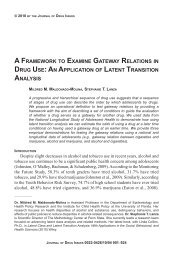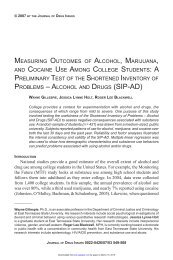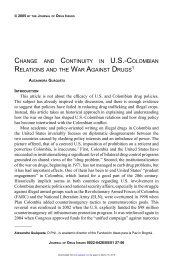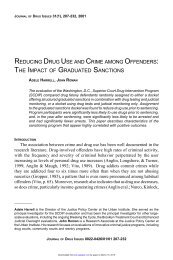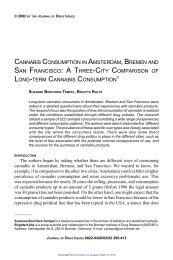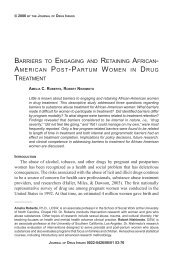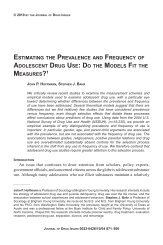a brief history of cannabis policies in spain - Journal of Drug Issues
a brief history of cannabis policies in spain - Journal of Drug Issues
a brief history of cannabis policies in spain - Journal of Drug Issues
You also want an ePaper? Increase the reach of your titles
YUMPU automatically turns print PDFs into web optimized ePapers that Google loves.
GAMELLA, JIMÉNEZ RODRIGO<br />
NEW DRUG FADS, NEW COHORTS, NEW PROBLEMS<br />
Although relatively few people <strong>in</strong>itiated opiate use after 1992, other forms <strong>of</strong><br />
drug use have ga<strong>in</strong>ed salience among the youth population. The ma<strong>in</strong> polydrug<br />
patterns <strong>in</strong>cluded the occasional social sniff<strong>in</strong>g <strong>of</strong> coca<strong>in</strong>e, public dr<strong>in</strong>k<strong>in</strong>g <strong>in</strong><br />
weekend street alcohol b<strong>in</strong>ges (“El botellón”), and the spread <strong>of</strong> new “lab” or<br />
“synthetic drugs” such as ecstasy and amphetam<strong>in</strong>e <strong>in</strong> powder form (“speed”).<br />
This has produced new drug-related problems affect<strong>in</strong>g a more affluent generation<br />
<strong>of</strong> Spaniards (see Gamella & Alvarez, 1999, Diaz, Barruti, & Doncel, 1992). As<br />
noted earlier, the consumption <strong>of</strong> <strong>cannabis</strong>, coca<strong>in</strong>e, and ecstasy <strong>in</strong> Spa<strong>in</strong> is among<br />
the highest reported <strong>in</strong> the EU (see EMCDDA, 2003).<br />
The occasional and social use <strong>of</strong> coca<strong>in</strong>e has reta<strong>in</strong>ed its popularity. Problem<br />
use has been concentrated among hero<strong>in</strong> addicts who <strong>in</strong>jected, and <strong>in</strong>creas<strong>in</strong>gly<br />
smoked the drug <strong>in</strong> free-base form (Barrio, Vicente, Bravo, & de la Fuente, 1993;<br />
Barrio et al., 2000). There is also a sizable population <strong>of</strong> “pure” coca<strong>in</strong>e problem<br />
users, and their treatment demands <strong>in</strong>creased rapidly <strong>in</strong> the late 1990s. In 2002,<br />
there were more demands for treatment associated with coca<strong>in</strong>e than with hero<strong>in</strong><br />
(OED, 2003). F<strong>in</strong>ally, there is <strong>in</strong>creas<strong>in</strong>g evidence <strong>of</strong> the use <strong>of</strong> free-base varieties,<br />
mostly <strong>in</strong> comb<strong>in</strong>ation with hero<strong>in</strong> (Barrio et al., 2000).<br />
THE GROWTH AND NORMALIZATION OF CANNABIS CONSUMPTION<br />
The use <strong>of</strong> <strong>cannabis</strong> escalated <strong>in</strong> the second half <strong>of</strong> the 1990s (see Table 1).<br />
This trend was <strong>in</strong> l<strong>in</strong>e with developments <strong>in</strong> the rest <strong>of</strong> Europe, North America,<br />
and Australia. The <strong>in</strong>crease was especially significant among teenagers. The national<br />
system <strong>of</strong> biannual surveys <strong>of</strong> high school students (14 to 18 years old) has revealed<br />
a cont<strong>in</strong>uous <strong>in</strong>crease <strong>in</strong> the percentage <strong>of</strong> youths that have tried <strong>cannabis</strong> and<br />
cont<strong>in</strong>ued us<strong>in</strong>g it s<strong>in</strong>ce the first survey was taken <strong>in</strong> 1994 (see Table 2).<br />
In the last school survey on drug use, adm<strong>in</strong>istered <strong>in</strong> 2002, the mean age <strong>of</strong><br />
<strong>in</strong>itiation for smok<strong>in</strong>g hash or marijuana was 14.7 years <strong>of</strong> age, and 22% <strong>of</strong> high<br />
school students said they had smoked <strong>cannabis</strong> dur<strong>in</strong>g the last 30 days, compared<br />
to 28% that had smoked tobacco. Those who had tried <strong>cannabis</strong> before reach<strong>in</strong>g<br />
adult status (18 years <strong>of</strong> age) were a majority. About 60% <strong>of</strong> students who had<br />
tried <strong>cannabis</strong> cont<strong>in</strong>ued us<strong>in</strong>g it. Male <strong>cannabis</strong> users consume more <strong>of</strong>ten than<br />
females, although these differences are smaller than those for other illegal<br />
substances, such as coca<strong>in</strong>e or amphetam<strong>in</strong>e. Cannabis users tend to consume<br />
tobacco and alcohol as well. However, there is a grow<strong>in</strong>g portion, close to 30%, <strong>of</strong><br />
“pure” users <strong>of</strong> <strong>cannabis</strong> who do not smoke tobacco (OED, 2002a).<br />
Officials from the National Plan on <strong>Drug</strong>s are concerned about the <strong>in</strong>crease <strong>in</strong><br />
<strong>cannabis</strong> consumption and the precocity <strong>of</strong> <strong>in</strong>itiation to this drug (OED, 2000, p.<br />
22; OED, 2003). These developments seem to belie their strategy <strong>of</strong> “prevention”<br />
640 JOURNAL OF DRUG ISSUES<br />
Downloaded from jod.sagepub.com by guest on March 15, 2015








